Students’ Written Responses to Holocaust Survivor Nessy Marks

Students’ Written Responses to Holocaust Survivor Nessy Marks
Peitho Volume 23 Issue 3, Spring 2021
Author(s): Elizabeth McGhee Williams and Kate Pantelides
Elizabeth McGhee Williams and Kate Pantelides work together in administrative and research contexts at Middle Tennessee State University. Elizabeth is a Ph.D. Candidate in English, Graduate Student Instructor, and Program Assistant for the General Education English program. Her research interests include feminist rhetoric, critical discourse studies, and writing program administration. Her work has been published in Rhetoric Society Quarterly. Kate is an Associate Professor and Director of General Education English, Past Co-Chair of the CCCC Feminist Caucus, and Past-President of WPA Midsouth. She teaches rhetoric and writing courses at the undergraduate and graduate levels. Much like Elizabeth, her research interests include rhetorical genre studies, discourse analysis, feminist rhetorics, and writing program administration. Her collaborative textbook project, Try This: Research Methods For Writers, is forthcoming. Although this is the first article Elizabeth and Kate have published together, they have collaborated on numerous programmatic events and pedagogical materials. Their current study with Harlow Crandall and Erica Stone examines the affective component of student placement in prescribed English courses.
Abstract: When Holocaust survivor Nessy Marks passed away in 2011, one of her most valued possessions, a collection of thank you letters written to her by the children from the many schools and places of worship she visited during her lifetime, found its home at our university. This report on in-progress work describes our efforts to recover, preserve, and analyze the letters in this archive. We highlight two trends in these letters: that of writers to affiliate with Ms. Marks through a sense of patriotism and duty, or through ancestry as a way of connecting to guilt and pain.
Tags: archive, Holocaust, Letters, LithuaniaMy five friends and I made a commitment to each other in the ghetto… Whoever survives must teach and tell the others. I am the only survivor, and I have kept my promise. (Nessy Marks)
Holocaust survivor Nessy Marks’ letter archive came to us – the students and faculty in a Feminist Methods seminar1 – because the other archives to which it had been offered could not give it a home. When Marks passed away in 2011, numerous museums and archives took her personal papers and artifacts, but one of her most valued possessions, a collection of thank you letters written by the thousands of American students to whom she spoke about the Holocaust during her lifetime, was not one of the items they selected for preservation. Luckily, Dr. Elyce Rae Helford, director of Jewish and Holocaust studies at MTSU, saved this archive and gifted it to our class. As the epigram for this manuscript highlights, Marks committed to tell her story of the Holocaust were she to survive, and she lived out this promise by speaking to school-age children, the people she believed would be most important to reach in order to prevent future violence. Our class worked together as a research team to document and categorize each artifact within the recovered archive, and with the help of Lauren Blade, a Research Assistant for the project, we were able to digitize the collection and add metadata. Our next step is to create a searchable database so that other feminist scholars can access and use the archive for further research.
Nessy Marks’ Life
Nessy Wolpert Marks was born in Pӧszeiten, Lithuania in 1924. In October 1938, the Nazis occupied Pӧszeiten, and Marks, along with her parents and four brothers, were relocated to the Kovno ghetto. In order to survive the relentless cruelty of the Nazi regime, Marks was at first sent into hiding with a local Catholic family in the hopes that she might have a chance for survival. She later accepted transport to a farm in northern Germany where she stayed until liberation in 1945.
In December 1947, Marks relocated to Tennessee to live with family in the United States. Soon after, she met and married her husband and gave birth to their four children. When she died in 2011 at the age of 87, she had travelled the U.S., speaking to students about her experiences during the war. Marks had kept the promise she made to her friends while in the Kovno ghetto: to tell their stories to the world (Tennessee Holocaust Commission). Upon recalling her vow in an interview, she stated:
it devastates me to this day but I do go into schools, I do go into churches and I’ve spoken to tens of thousands of people by now. I have files and files, when I was young and dumb I threw the thank you letters, threw the letters away but I still have on file at least 1500 letters, you know, of students and teachers. (Oral History)
In this interview extract, Marks demonstrates an awareness of the value of these letters, and our research team concurs that these texts hold significant power and insight.
Description of the Archive
In total, the archive is composed of more than 1500 letters and personal artifacts from Marks’ life, such as newspaper clippings, conference programs, and photographs. The letters, which are the focus of our study, were written between 1960-2006 by students ranging in age from 9 to 19 years old. It is likely that some of these children would have had immediate family members who survived the Holocaust, adding another layer of nuance to their reception of Marks’ survivor narrative.
Marks’ documents are preserved in the order and state in which we received them – eight binders with letters encased in plastic sleeves. The letters are organized such that student letters from a particular class are adjacent to each other; however, instructor name and grade level are not always noted. Further, different classes are not organized chronologically within binders. We include sample letters with our findings below and have removed identifying features from these donated letters.
Feminist Approach to the Archive
Sharlene Nagy Hesse-Biber posits that a project can be “considered ‘feminist’ when it is grounded in the set of theoretical traditions that privilege women’s issues, voices, and lived experiences” (3). Marks’ personal archive of student letters represents such a project – one that demonstrates the effect her lived experiences had on those with whom she shared her story of survival. Approaching Marks’ letters with a feminist lens allows us to not only consider the potential knowledge to be gained from undervalued texts (such as handwritten letters) and undervalued rhetors (such as adolescents), but brings forth a marginalized voice whose commitment to telling her story of the Holocaust and warning future generations about the repercussions of unfettered violence was her life’s work.
As feminist scholars have well-demonstrated, “thousands of men’s lives have been recognized and recorded for centuries across cultures, [but] women’s life stories have been documented far less often, even forgotten” (Brooks). Marks was a volunteer educator, wife, and mother, but because these titles go largely unacknowledged as part of the domestic sphere, her work has not received the attention and understanding it deserves. Marks’ story is particularly important because “the problem of integrating victim testimony into the history of Nazism and the Holocaust has emerged as one of the new developments in recent Holocaust historiography” (Betts and Wiese 6). The purpose in recovering this archive, then, is to highlight Marks’ contribution and claim such space as worthy of feminist scholarship and research.
Methodology
Our research team worked together to establish agreed-upon codes for our data analysis. We shared and discussed our findings collectively, recursively honing and revising codes, and subsequently analyzing the trends we observed in individual artifacts. We acknowledge that the context in which we conducted our research – a feminist research methods graduate course – influenced how we interpreted our data, and reflecting on our own subjectivities was focal to our coursework. Practicing such reflexivity of course prompts “researchers to account for their personal biases and examine the effects that these biases may have on the data produced” (Hesse-Biber 3).
Findings
The first letter (Figure 1) that we examined was written by a fourth grader in 1968. The student thanks Marks for her visit and notes how “exiting” (sic) Germany must have been during the Holocaust. In fact, the student notes, without judgment, that after her talk “Some of the fourth graders were playing [Holocaust] on the playground.” Although there was a collective gasp in the room when we read this aloud together, upon further reflection we came to recognize that this reaction – students playing – was the way they were able to make sense of something so horrifying, something that defies sense-making.
More troubling than this student’s admission of “playing Holocaust,” however, is the number of students who seemed detached or disconnected from Marks’ often graphic retelling of her experiences, though we recognize such a reaction, again, as a common response to difficult material. This apparent dissociation demonstrates what psychologists in trauma studies have identified as “compassion fatigue.” In “The Fragility of Empathy After the Holocaust,” Carolyn Dean cites this condition as a common concern in Holocaust education, as people become numb to narratives and images of suffering as a form of self-protective dissociation.
Of course, the accounts represented in these letters are not necessarily “true” representations of student perceptions of the Holocaust. Instead – we suggest just as interestingly – they offer differing written responses across ages and places to a survivor narrative. For instance, some students only refer to Marks’ “experiences” but do not use the word “Holocaust,” and some simply avoid reference of either term.2 Further, we were surprised by the relatively low percentage of students whose letters – in any capacity – mentioned violence, not only because of the centrality of violence in any account of the Holocaust, but especially because Marks’ retellings focused on the atrocities that surrounded her.3
This absence – of direct references to the Holocaust in much of the discourse within the archive – underscores the real threat of discarding these letters: forgetting the violence that occurred under the Nazi regime and opening ourselves up to the possibility of recurrence. Decades after the Holocaust, anti-Semitic hate crimes remain widespread. According to the Anti-Defamation League, “assault, harassment and vandalism against Jews remain at near-historic levels in the U.S.,” and anti-Semitism is rising globally, with over one-billion people expressing anti-Semitic views in a 2014 poll. As our research team worked with this archive, our goal became clear – to keep Marks’ voice alive and make this archive accessible to others to help prevent detachment and avoidance of Holocaust narratives.
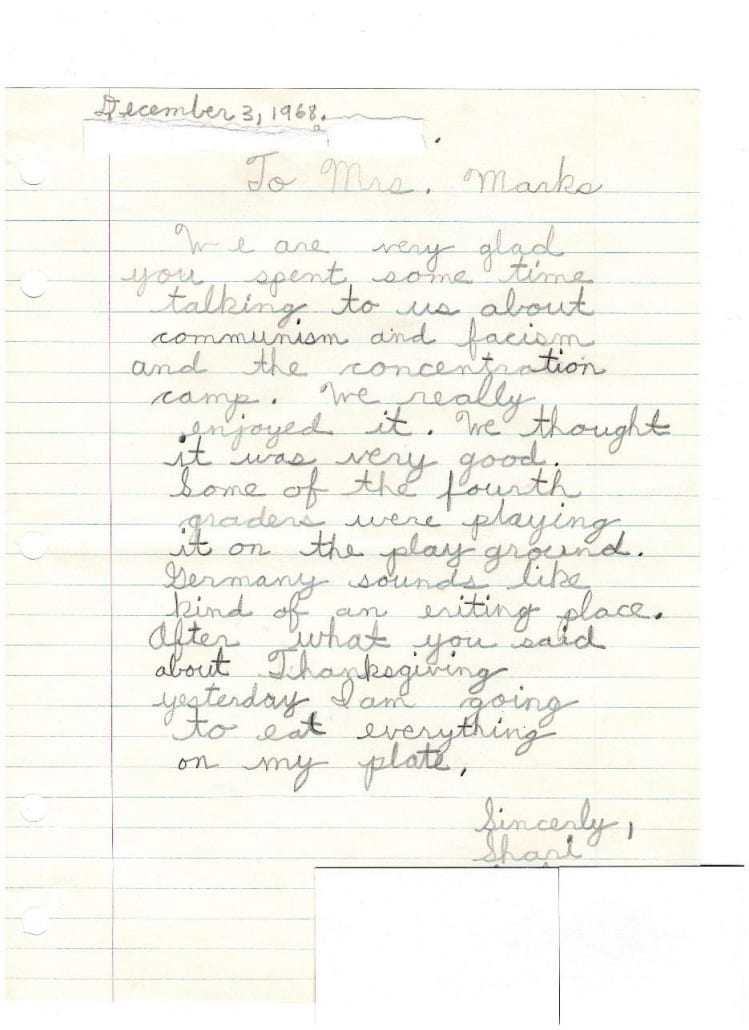
Figure 1, Letter B3-L4
Within the corpus of student letters written to Marks, two strategies emerged for affiliating with and demonstrating care for Nessy Marks as a survivor. In particular, 1) writers used collective pronouns to affiliate with Marks and construct themselves as patriotic protectors taking on what they saw as American responsibility;4 and 2) letter writers identified ancestry as a strategy for affiliation, accepting Marks’ story either as one that absolves them of guilt or connects them to painful narratives.5
Attention to Pronoun Use: Representations of Patriotism and Empathy
The changing use of pronouns in the letter archive was particularly notable and reflective of what communication scholars Kathleen Haspel and Karen Tracy have identified as ways that authors use pronouns to affiliate or disaffiliate with particular groups or ideas. For instance, in their analysis of the discursive strategies used during a disagreement at a school board meeting, Haspel and Tracy note how the use of “we and they simultaneously express alignment and affiliation with some people and disaffiliation and nonalignment with others” (148).
Similarly, we noted as particularly marked letters expressing students’ patriotism and militarism through the use of inclusive pronouns. One set of letters, dated from 1986, are largely characterized by their expressions of a sense of American duty and responsibility to world security, with “we” rhetoric heavily relied upon. The use of this repeated collective pronoun throughout the corpus, particularly in the late 80s, suggests a common belief among the students that the United States “won” the war and “saved” the Jewish people from the Nazis; this ideology aligns with a renewed sense of patriotism constructed in America in the 1980s (Rajecki et al.).
Although many of the letters utilize “we” to demonstrate care and community, violent expressions of force and/or military use are often written in first person. The desire for violent reactions to Marks’ story are expressed in a singular way through the use of the pronoun “I,” while expressions of guilt and patriotism are usually demonstrated in a collective sense. The following letter excerpt (Figure 2) is a representative example of the students’ use of violent notions of duty or responsibility to save the Jewish people, as in, “When I really think about it, I wish I could have formed an army and killed Hitler.”
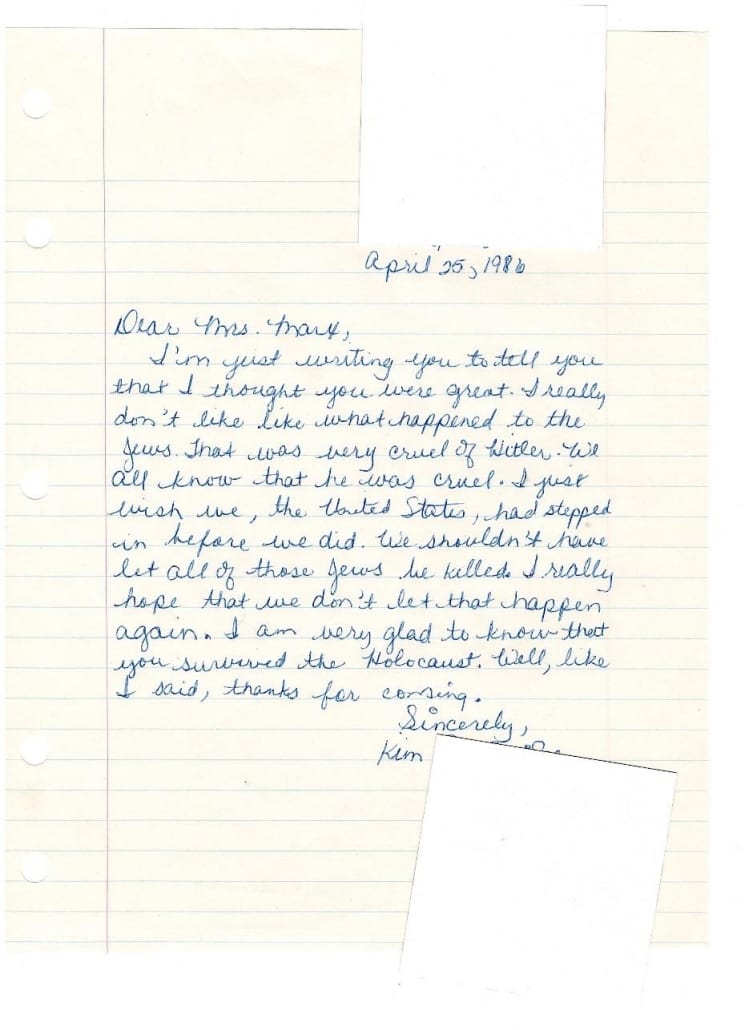
Figure 2, Letter B4-L6
In further constructions of empathy,6 the frequent use of the pronoun “I” demonstrates affiliation with Marks as a survivor. While we would expect “I” to be used frequently in a personal letter, “I” seemed to function metonymically, such that the child writer stood in for the Jewish people in the context of the thank you letter. This tendency is illustrated in the following excerpt (Figure 3): “I will never forget when you said that children with dark hair were thrown into trucks and suffocated. I realize I am the only person in my family with dark hair, and I could have been mistaken for Jewish, but I’m really Polish.”
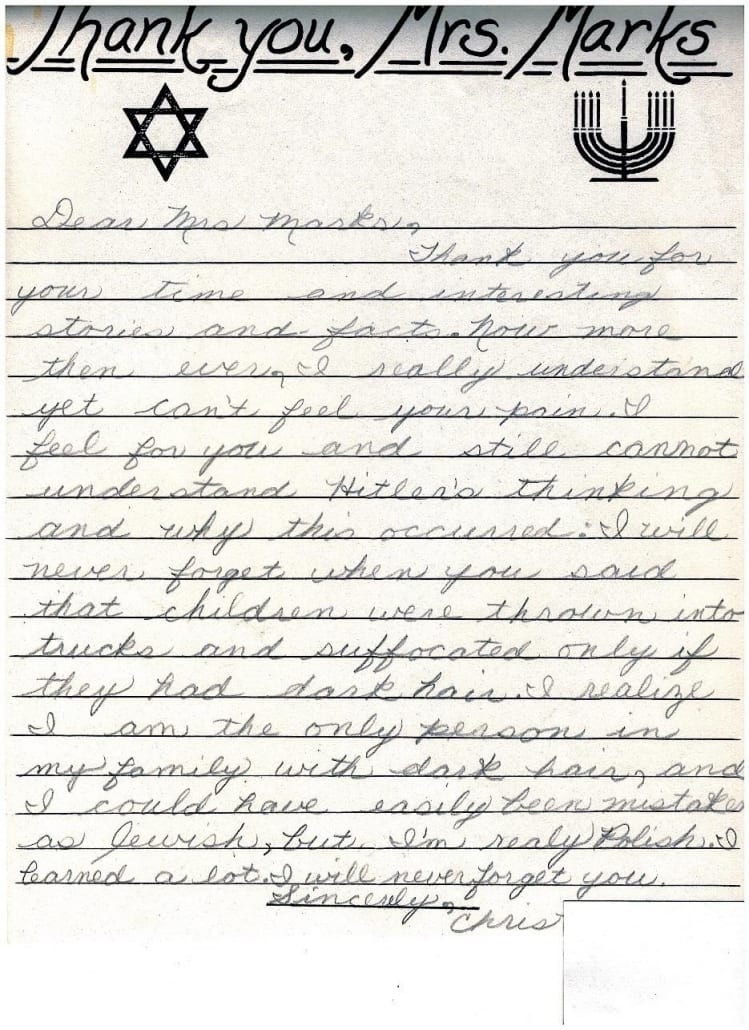
Figure 3, Letter B8-L13
Letters we coded as empathetic are also marked by their use of collective pronouns “us” and “we.” These samples demonstrate a sense of solidarity and a shared need to atone for the atrocities suffered by Jews during the Holocaust. The letters coded as sympathetic overwhelmingly utilize the pronoun “you” as a mechanism for expressing concern while also using Marks’ story as a transferable lesson for a universal audience. These expressions of concern and words of advice are demonstrated in Figure 4: “[I] hope you can sleep tonight” and “You should never come home and say you are starving.”
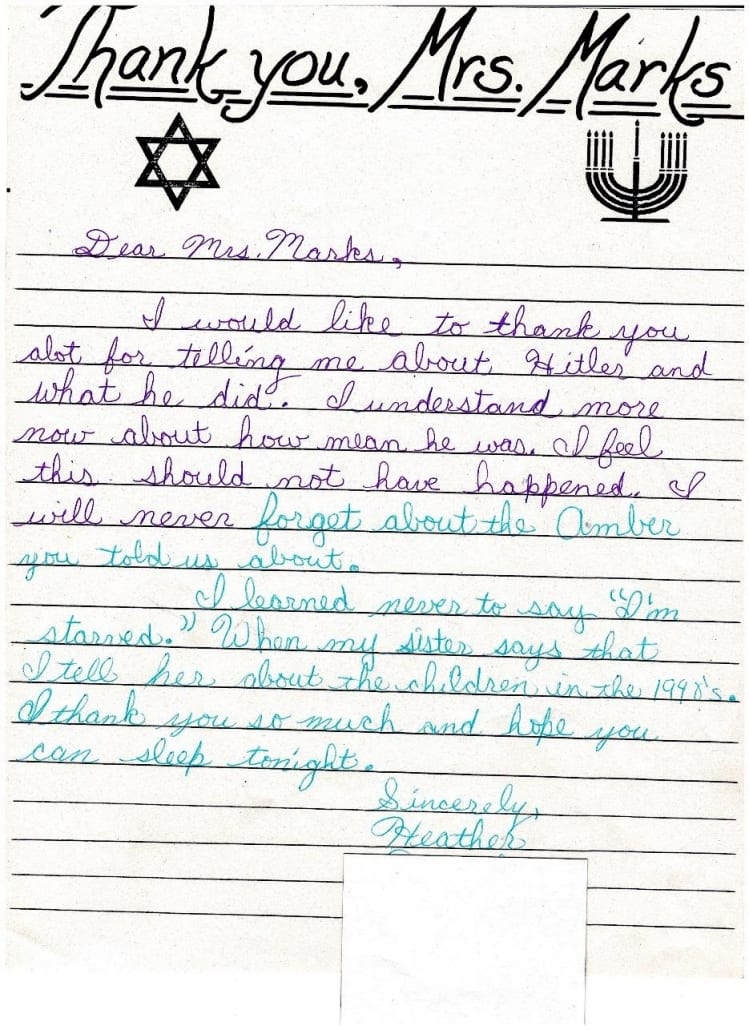
Figure 4, Letter B8-L7
Ancestry as Connection to Narratives of Guilt and Pain
While pronoun use is one significant strategy to affiliate with Marks, many letters also use heritage as a way to connect to Marks and her experiences. In particular, students of Jewish descent shared expressions of inherited pain and solidarity. One student writes, “A lot of what you [Marks] said has really affected me because many of my distant family either died or did survive the Holocaust. So many things you said also happen[ed] to my family.” This account attempts to establish a direct connection to Marks’ experiences in order to form a common bond with Holocaust victims.
Conversely, in Figure 5, one letter writer claiming to have ties to Germany thanks Marks for not condemning her descendants: “I am of German descent and I really would like to thank you for saying it was not our fault my grandma’s aunt’s boyfriend Adolf Hitler turned against the Jews and other races.” This account expresses a sense of inherited guilt that was demonstrated in several of the letters written by students claiming German heritage, but it simultaneously takes pains to connect the writer to Hitler, a strange tension worthy of further analysis.
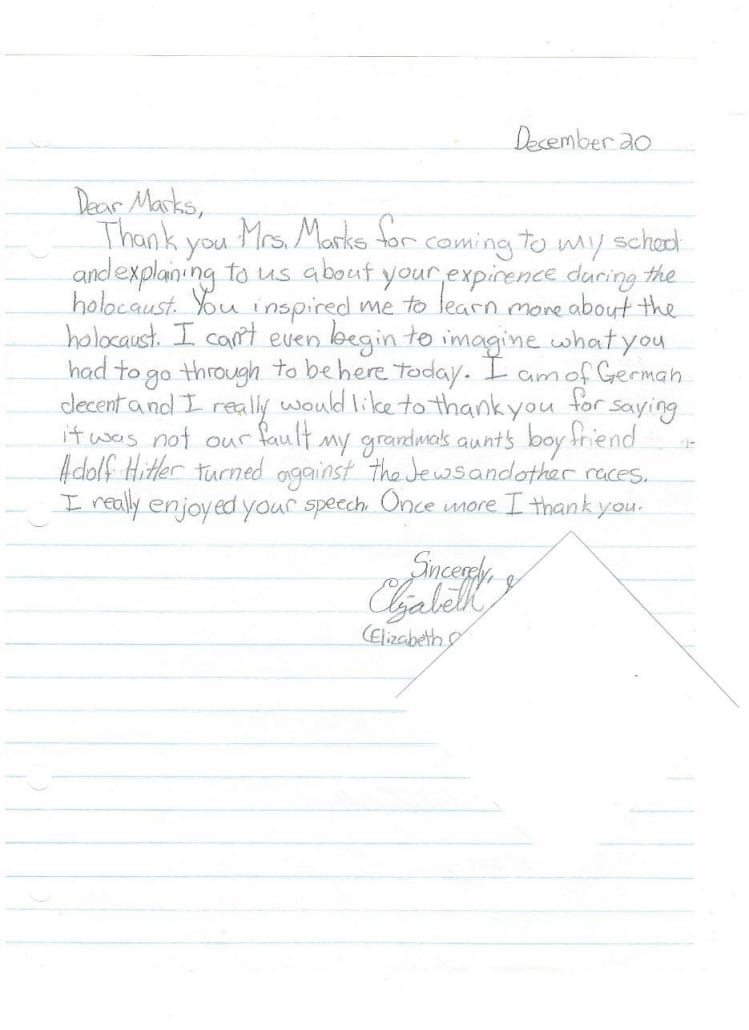
Figure 5, Letter B2-L21
Conclusion
If we do not properly document and preserve historical materials such as Marks’ letters, what stories of Holocaust survivors will stop being told? What lessons will we fail to learn? It is our responsibility as feminist scholars and researchers – the people who strive to recover the voices of the underrepresented – to ensure that the voices of Holocaust survivors such as Marks continue to have a presence in our history, scholarship, and collective memory.
This archive represents a way to keep Marks’ story alive – through the letters written to her from appreciative students, and the personal documents that give us small glimpses into her lived experiences as a Holocaust survivor. We have only begun to discover the rich experiences within this archive. Our goal is that the recovery of Marks’ personal belongings and the digitization of these letters will allow others to find value in this archive and, perhaps most importantly, allow Marks to continue to keep her promise to those five friends she lost in the Kovno ghetto so long ago.
Questions & Considerations for Future Engagement
This study demonstrates the importance of examining non-traditional forms of knowledge (such as underappreciated archival material and works produced by children) critically and seriously in order to broaden the definition of what is considered worthy of academic study, particularly for scholars interested in feminist recovery work. Marks’ archive of letters represents an untapped opportunity for feminists in rhetoric, writing studies, communication, archival studies, Holocaust studies, discourse analysis, and beyond. The following research questions offer only a starting point for further exploration.
- In what ways does this archive demonstrate the power of storytelling and its ability to keep a community (Holocaust survivors) and a historical event (the Holocaust) alive?
- What knowledge can be gleaned from examining changes in children’s responses to the Holocaust over time? (Especially in times of war and/or violence)
- What implications does this archive offer for teaching social justice to adolescents? How can we make sense of their reactions to violence?
- In what ways does this archive contribute to public memory of the Holocaust in America?
- What does this archive reveal about the discourse of heroism in American society?
- How can public engagement with this archive provide a generative opportunity for learners at all stages? (Particularly at a moment when hate speech and crimes are on the rise in our country)
End Notes
- Our research team included Elizabeth Williams (first author on this manuscript), Kate Pantelides (faculty member), Katherine Musick, Michelle Joyner, Nailah Herbert, and Helen Wilds. Their contributions are included in this summary of our work in progress. -return to text
- Michelle Joyner’s research focused on the element of detachment in the student letters. -return to text
- In one sample of letters, for instance, 30% mentioned violence, torture, etc. in broad, general, or vague terms; only 21% mentioned specific acts of violence. -return to text
- Helen Wilds and Nailah Herbert focused on this aspect of the archive. -return to text
- Katherine Musick focused on this aspect of the archive. -return to text
- Nailah Herbert was especially interested in this aspect of the letter in her analysis. -return to text
Works Cited
- “Anti-Semitism in the US.” Anti-Defamation League, 2020, www.adl.org/what-we-do/anti-semitism/anti-semitism-in-the-us. -return to text
- Betts, Paul, and Christian Wiese. Years of Persecution, Years of Extermination: Saul Friedlander and the Future of Holocaust Studies. Continuum, 2010. -return to text
- Brooks, Abigail. “Feminist Standpoint Epistemology: Building Knowledge and Empowerment Through Women’s Lived Experience.” Feminist Research Practice. Edited by Sharlene Nagy Hesse-Biber and Patricia L. Leavy, Sage, 2007, pp. 53-82, doi: 10.4135/9781412984270. -return to text
- Dean, Carolyn J. “The Fragility of Empathy after the Holocaust.” Cornell UP, 2004. -return to text
- Haspel, Kathleen, and Karen Tracy. “Marking and Shifting Lines in the Sand.” The Prettier Doll: Rhetoric, Discourse, and Ordinary Democracy, edited by Bruce E. Gronbeck et al., U of Alabama P, 2007, pp. 142-175. -return to text
- Hesse-Biber, Sharlene Nagy. Feminist Research Practice. Sage, 2014. -return to text 1 or 2
- Marks, Nessy. Oral history interview with Eric Epstein. United States Holocaust Memorial Museum, 24 July 1996, www.collections.ushmm.org/search/catalog/irn513419. -return to text
- “Nessy Marks.” Tennessee Holocaust Commission. 2009, www.tnholocaustsurvivorsarchive.org/people/nessy-marks/. -return to text
- Rajecki, D. W., et al. “Documentation of Media Reflections of the Patriotic Revival in the United States in the 1980s.” Journal of Social Psychology, vol. 131, no. 3, June 1991, pp. 401–411, doi: 10.1080/00224545.1991.9713866. -return to text